Millions of people in the U.S. are affected by mental illness each year. It’s important to measure how common mental illness is, so we can understand its physical, social and financial impact — and so we can show that no one is alone. These numbers are also powerful tools for raising public awareness, stigma-busting and advocating for better health care.
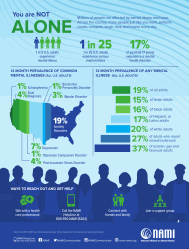 | 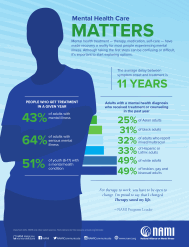 | 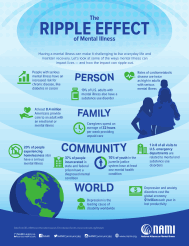 |
| Download the infographic You Are Not Alone | Download the infographic Mental Health Care Matters | Download the infographic The Ripple Effect of Mental Illness |
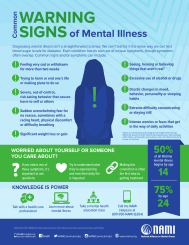 | 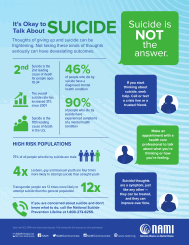 |
| Download the infographic Common Warning Signs of Mental Illness | Download the infographic It's Okay to Talk About Suicide |
The information on these infographics and this page comes from studies conducted by organizations like Substance Abuse and Mental Health Services Administration (SAMHSA), Centers for Disease Control and Prevention (CDC) and the U.S. Department of Justice. The terminology used reflects what is used in original studies. Terms like “serious mental illness,” “mental illness” or “mental health disorders” may all seem like they’re referring to the same thing, but in fact refer to specific diagnostic groups for that particular study.
If you have questions about a statistic or term that’s being used, please visit the original study by clicking the link provided.
1 in 5 U.S. adults experience mental illness each year
1 in 25 U.S. adults experience serious mental illness each year
1 in 6 U.S. youth aged 6-17 experience a mental health disorder each year
50% of all lifetime mental illness begins by age 14, and 75% by age 24
Suicide is the 2nd leading cause of death among people aged 10-34
You Are Not Alone
- 19.1% of U.S. adults experienced mental illness in 2018 (47.6 million people). This represents 1 in 5 adults.
- 4.6% of U.S. adults experienced serious mental illness in 2018 (11.4 million people). This represents 1 in 25 adults.
- 16.5% of U.S. youth aged 6-17 experienced a mental health disorder in 2016 (7.7 million people)
- 3.7% of U.S. adults experienced a co-occurring substance use disorder and mental illness in 2018 (9.2 million people)
- Annual prevalence of mental illness among U.S. adults, by demographic group:
- Annual prevalence among U.S. adults, by condition:
- Major Depressive Episode: 7.2% (17.7 million people)
- Schizophrenia: <1% (estimated 1.5 million people)
- Bipolar Disorder: 2.8% (estimated 7 million people)
- Anxiety Disorders: 19.1% (estimated 48 million people)
- Posttraumatic Stress Disorder: 3.6% (estimated 9 million people)
- Obsessive Compulsive Disorder: 1.2% (estimated 3 million people)
- Borderline Personality Disorder: 1.4% (estimated 3.5 million people)
Mental Health Care Matters
- 43.3% of U.S. adults with mental illness received treatment in 2018
- 64.1% of U.S. adults with serious mental illness received treatment in 2018
- 50.6% of U.S. youth aged 6-17 with a mental health disorder received treatment in 2016
- The average delay between onset of mental illness symptoms and treatment is 11 years
- Annual treatment rates among U.S. adults with any mental illness, by demographic group:
- 11.3% of U.S. adults with mental illness had no insurance coverage in 2018
- 13.4% of U.S. adults with serious mental illness had no insurance coverage in 2018
- 60% of U.S. counties do not have a single practicing psychiatrist
The Ripple Effect Of Mental Illness
PERSON
- People with depression have a 40% higher risk of developing cardiovascular and metabolic diseases than the general population. People with serious mental illness are nearly twice as likely to develop these conditions.
- 19.3% of U.S. adults with mental illness also experienced a substance use disorder in 2018 (9.2 million individuals)
- The rate of unemployment is higher among U.S. adults who have mental illness (5.8%) compared to those who do not (3.6%)
- High school students with significant symptoms of depression are more than twice as likely to drop out compared to their peers
FAMILY
- At least 8.4 million people in the U.S. provide care to an adult with a mental or emotional health issue
- Caregivers of adults with mental or emotional health issues spend an average of 32 hours per week providing unpaid care
COMMUNITY
- Mental illness and substance use disorders are involved in 1 out of every 8 emergency department visits by a U.S. adult (estimated 12 million visits)
- Mood disorders are the most common cause of hospitalization for all people in the U.S. under age 45 (after excluding hospitalization relating to pregnancy and birth)
- Across the U.S. economy, serious mental illness causes $193.2 billion in lost earnings each year
- 20.1% of people experiencing homelessness in the U.S. have a serious mental health condition
- 37% of adults incarcerated in the state and federal prison system have a diagnosed mental illness
- 70.4% of youth in the juvenile justice system have a diagnosed mental illness
- 41% of Veteran’s Health Administration patients have a diagnosed mental illness or substance use disorder
WORLD
- Depression and anxiety disorders cost the global economy $1 trillion in lost productivity each year
- Depression is the leading cause of disability worldwide
It’s Okay To Talk About Suicide
- Suicide is the 2nd leading cause of death among people aged 10-34 in the U.S.
- Suicide is the 10th leading cause of death in the U.S.
- The overall suicide rate in the U.S. has increased by 31% since 2001
- 46% of people who die by suicide had a diagnosed mental health condition
- 90% of people who die by suicide had shown symptoms of a mental health condition, according to interviews with family, friends and medical professionals (also known as psychological autopsy)
- Lesbian, gay and bisexual youth are 4x more likely to attempt suicide than straight youth
- 75% of people who die by suicide are male
- Transgender adults are nearly 12x more likely to attempt suicide than the general population
- Annual prevalence of serious thoughts of suicide, by U.S. demographic group:
Keine Kommentare:
Kommentar veröffentlichen